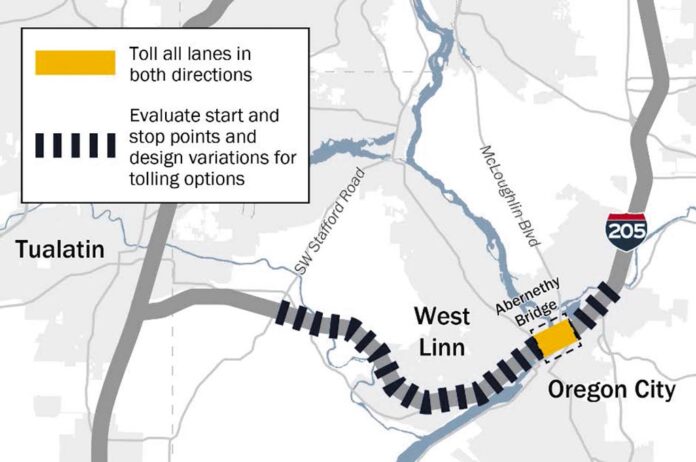
Equity and Mobility Advisory Committee seeks wider input
An Oregon Department of Transportation (ODOT) plan to toll portions of Interstate 205 is moving forward despite strong public opposition and questions from some public officials.
“Tolling is not real popular,” Washington County Commissioner Roy Rogers said during a March 9 county commission work session.
A draft ODOT report summarizing the public engagement process was published last fall and its findings are equally blunt. “A majority of respondents across all demographic groups and commenting methods expressed strong opposition to tolling in general or to the specifics of the I-205 Toll Project as it is currently proposed,” reads the first of several key takeaways listed in the report, none of which suggest support for the tolling proposal.
Nonetheless, the plan continues to move forward, with ODOT now also planning to implement tolls on Interstate 5, as well. Ultimately, the state hopes to toll both interstate highways throughout the entirety of the Portland metro area.
According to ODOT, it is currently studying a series of tolling options with the intent of choosing a preferred alternative with the help of the Federal Highway Administration at some time in 2022. A plan to toll I-205 is also undergoing environmental assessment at present.
ODOT’s latest effort at community engagement comes in the form of the Equity and Mobility Advisory Committee (EMAC), a group that is seeking input from historically underrepresented or marginalized communities. This includes the historically Black community in the Albina district of Northeast Portland, which saw the destruction of hundreds of homes and businesses in the late 1950s during the initial construction of Interstate 5.
Washington County is represented on the EMAC by County Community Engagement Manager Amanda Garcia-Snell, who works in the Office of Equity and Inclusion and Community Engagement. She told the Board of Commissioners that the group began meeting last fall and is examining both equity of process and equity of outcomes, two distinct concepts.
“By full participation, that means impacted communities will play a major role throughout the project,” Garcia-Snell said.
Affordability, improving access to multimodal forms of transportation, including public transit, and community health will also be areas of focus, she added.
“The toll project will explore air quality, safety, economic impact and other potential impacts to historically underserved communities,” she said. “As you know, community health is broad, so that also includes the impacts of re-routed traffic and things like that.”
Beyond that, ODOT says the tolling project is intended to both manage congestion and raise revenue for highway improvement projects, including a replacement for the narrow I-205 Abernethy Bridge across the Willamette River in Oregon City.
When it comes to equity, however, Rogers noted that this concept perhaps does not extend to Oregonians outside the metro area. Nor, he added, is it yet clear where revenue from tolling will ultimately be spent.
“These are federal highways, and we have people who drive these highways from Medford, from Eugene, all south, east, and not too much west, but they have folks who would have some difficulties in paying tolls,” Roger said. “And they have the equity issue just the same.”
Other commissioners are more supportive of tolling and would like to see a faster approval process.
“I think that’s a little frustrating to me considering that our transportation funding sources are significantly limited where we have a legislature that’s extremely resistant to increasing the gas tax,” Commissioner Jerry Willey said.
To find out more, visit the ODOT Community Engagement Report.



















